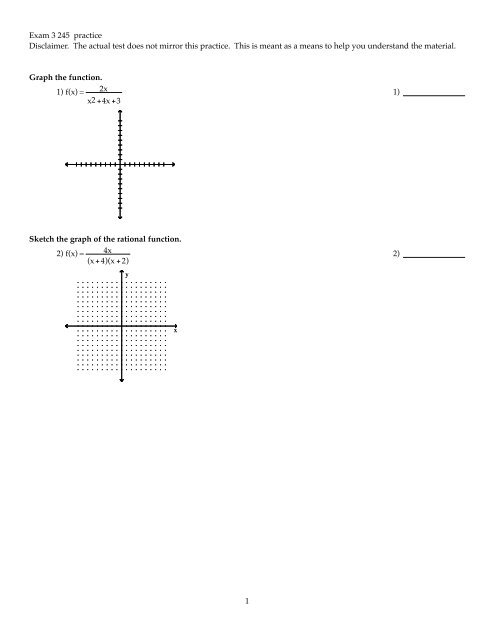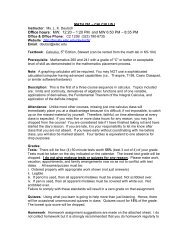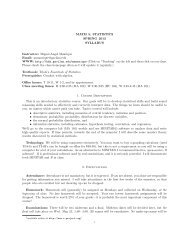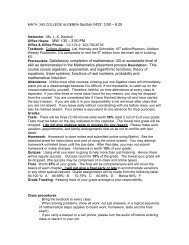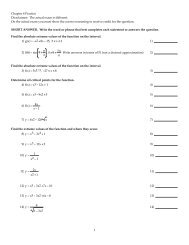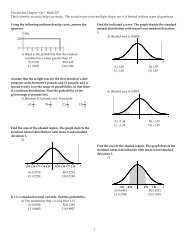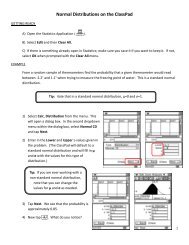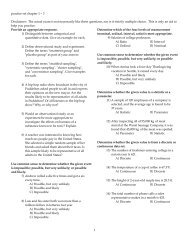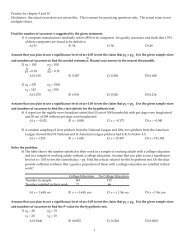Exam 3 245 practice Disclaimer. The actual test does not mirror this ...
Exam 3 245 practice Disclaimer. The actual test does not mirror this ...
Exam 3 245 practice Disclaimer. The actual test does not mirror this ...
You also want an ePaper? Increase the reach of your titles
YUMPU automatically turns print PDFs into web optimized ePapers that Google loves.
<strong>Exam</strong> 3 <strong>245</strong> <strong>practice</strong><br />
<strong>Disclaimer</strong>. <strong>The</strong> <strong>actual</strong> <strong>test</strong> <strong>does</strong> <strong>not</strong> <strong>mirror</strong> <strong>this</strong> <strong>practice</strong>. This is meant as a means to help you understand the material.<br />
Graph the function.<br />
1) f(x) = 2x<br />
x2 + 4x + 3<br />
1)<br />
Sketch the graph of the rational function.<br />
2) f(x) = 4x<br />
(x + 4)(x + 2)<br />
2)<br />
y<br />
x<br />
1
Identify any vertical, horizontal, or oblique asymptotes in the graph of y = f(x). State the domain of f.<br />
3)<br />
y<br />
3)<br />
6<br />
4<br />
2<br />
-6 -4 -2 2 4 6<br />
-2<br />
x<br />
-4<br />
-6<br />
A) Vertical: x = -3; horizontal: y = 0; (-∞, -3) ∪ (-3, ∞)<br />
B) Vertical: x = -3; horizontal: y = 0; (-∞, 0) ∪ (0, ∞)<br />
C) Vertical: x = 0; horizontal: y = -3; (-∞, -3) ∪ (-3, ∞)<br />
D) Vertical: x = 0; horizontal: y = -3; (-∞, 0) ∪ (0, ∞)<br />
Use synthetic division to perform the division.<br />
4) x3 - x 2 + 3<br />
x + 2<br />
4)<br />
Give the equation of the oblique asymptote, if any.<br />
5) f(x) = x2 + 2x - 3<br />
x - 4<br />
5)<br />
Use synthetic division to perform the division.<br />
6) x 4 - 3x3 - 15x2 - 17x - 6<br />
x - 6<br />
6)<br />
Give the equation of the oblique asymptote, if any.<br />
7) f(x) = x2 - 9x + 3<br />
x + 9<br />
7)<br />
Use synthetic division to perform the division.<br />
8)<br />
8)<br />
x3 - 7 2 x 2 + 9 2 x - 3 2<br />
x - 1 2<br />
9) x 4 - 3x3 - 7x2 - 14x - 5<br />
x - 5<br />
9)<br />
2
Use the remainder theorem and synthetic division to find f(k).<br />
10) k = 4 + i; f(x) = x3 + 10 10)<br />
Solve the problem. Round to the nearest tenth unless indicated otherwise.<br />
11) <strong>The</strong> volume of a gas varies inversely as the pressure and directly as the temperature (in<br />
degrees Kelvin). If a certain gas occupies a volume of 2.5 liters at a temperature of 380 K<br />
and a pressure of 20 newtons per square centimeter, find the volume when the<br />
temperature is 456 K and the pressure is 30 newtons per square centimeter.<br />
11)<br />
Use the remainder theorem and synthetic division to find f(k).<br />
12) k = -3 + 3i; f(x) = x2 + 5x + 4 12)<br />
Use synthetic division to perform the division.<br />
13) x 3 - 1<br />
x - 1<br />
13)<br />
Solve the problem.<br />
14) <strong>The</strong> weight that a horizontal beam can support varies inversely as the length of the<br />
beam. Suppose that a 5-m beam can support 730 kg. How many kilograms can a 10-m<br />
beam support?<br />
14)<br />
15) <strong>The</strong> current I in an electrical conductor varies inversely as the resistance R of the<br />
conductor. <strong>The</strong> current is 5 amperes when the resistance is 719 ohms. What is the current<br />
when the resistance is 420 ohms? Round to the nearest tenth.<br />
15)<br />
Solve the problem. Round to the nearest tenth unless indicated otherwise.<br />
16) <strong>The</strong> cost of stainless steel tubing varies jointly as the length and the diameter of the<br />
tubing. If a 5 foot length with diameter 2 inches costs $48.00, how much will a 11 foot<br />
length with diameter 5 inches cost? Round to the nearest cent.<br />
16)<br />
Use synthetic division to decide whether the given number k is a zero of the given polynomial function.<br />
17) 2 5 ; f(x) = 5x 4 + 3x2 - 4 17)<br />
Use the remainder theorem and synthetic division to find f(k).<br />
18) k = -2; f(x) = x6 + 3x5 - 3x4 + 4x3 + 3x2 - 4x - 6 18)<br />
Express f(x) in the form f(x) = (x - k)q(x) + r for the given value of k.<br />
19) f(x) = 2x 4 - x 3 - 15x 2 + 3x; k = -3 19)<br />
20) f(x) = 3x 3 - x 2 + 2x + 7; k = -1 20)<br />
Use synthetic division to decide whether the given number k is a zero of the given polynomial function.<br />
21) 2 + i; f(x) = x 3 + 2x 2 - 6x + 8 21)<br />
3
Find all complex zeros of the polynomial function. Give exact values. List multiple zeros as necessary.<br />
22) f(x) = x 4 - 32x 2 - 144 22)<br />
23) f(x) = x4 - 9 23)<br />
24) f(x) = x 4 - 45x 2 - 196 24)<br />
Use Descartes' Rule of Signs to determine the possible number of positive real zeros and the possible number of<br />
negative real zeros for the function.<br />
25) 6x 5 - 6x 4 + 7x 3 - 8 = 0 25)<br />
Find a polynomial of lowest degree with only real coefficients and having the given zeros.<br />
26) 4 + 6 , 4 - 6 , and 3 26)<br />
27) 2, -8, and 3 + 4i 27)<br />
Solve the problem. Round your answer to two decimal places.<br />
28) <strong>The</strong> area of a circle varies directly as the square of the radius of the circle. If a circle with<br />
a radius of 5 inches has an area of 78.5 square inches, what is the area of a circle with a<br />
radius of 20 inches?<br />
28)<br />
29) <strong>The</strong> distance to the horizon varies directly as the square root of the height above ground<br />
level of the observer. If a person can see 6 miles from a height of 25 feet, how far can a<br />
person see from a height of 49 feet?<br />
29)<br />
30) <strong>The</strong> weight W of an object on the Moon varies directly as the weight E on earth. A<br />
person who weighs 158 lb on earth weighs 31.6 lb on the Moon. How much would a<br />
125-lb person weigh on the Moon?<br />
30)<br />
Find a polynomial of lowest degree with only real coefficients and having the given zeros.<br />
31) 1 - 3, 1 + 3, and 1 + i 31)<br />
Find the zeros of the polynomial function and state the multiplicity of each.<br />
32) f(x) = (x 2 + 14x + 45) 2 32)<br />
Find all rational zeros and factor f(x).<br />
33) f(x) = 8x3 + 10x2 - 11x + 2 33)<br />
34) f(x) = 10x3 + 63x2 + 17x - 6 34)<br />
35) f(x) = 12x3 + 61x2 + 4x - 5 35)<br />
Use the remainder theorem and synthetic division to find f(k).<br />
36) k = -3; f(x) = 4x 3 - 6x 2 - 4x + 22 36)<br />
4
Find the zeros of the polynomial function and state the multiplicity of each.<br />
37) 5x(x - 7) 3 (x 2 - 16) 37)<br />
Use synthetic division to decide whether the given number k is a zero of the given polynomial function.<br />
38) -5 - 4i; f(x) = x2 + 10x + 41 38)<br />
Use the remainder theorem and synthetic division to find f(k).<br />
39) k = -3; f(x) = 6x 4 + 10x 3 + 2x 2 - 6x + 35 39)<br />
Use synthetic division to decide whether the given number k is a zero of the given polynomial function.<br />
40) -2; f(x) = -6x 3 + 3x 2 + x - 58 40)<br />
Use the remainder theorem and synthetic division to find f(k).<br />
41) k = 2 + i; f(x) = x3 + 10 41)<br />
Use the factor theorem to decide whether or <strong>not</strong> the second polynomial is a factor of the first.<br />
42) 8x 3 + 36x 2 - 19x + 5; x + 5 42)<br />
Use synthetic division to decide whether the given number k is a zero of the given polynomial function.<br />
43) 7i; f(x) = x3 + 2x2 + 49x + 98 43)<br />
For the function as defined that is one-to-one, graph f and f-1 on the same axes.<br />
44) f(x) = x + 6<br />
y<br />
10<br />
44)<br />
5<br />
-10 -5 5 10<br />
x<br />
-5<br />
-10<br />
Use synthetic division to decide whether the given number k is a zero of the given polynomial function.<br />
45) 1 2 ; f(x) = 2x 4 - 21x3 + 3x + 1 45)<br />
Factor f(x) into linear factors given that k is a zero of f(x).<br />
46) f(x) = x3 - (4 + 2i)x2 + (-5 + 8i)x + 10i; k = 2i 46)<br />
5
For the function as defined that is one-to-one, graph f and f-1 on the same axes.<br />
47) f(x) = 5 3 x + 4 x<br />
47)<br />
10<br />
y<br />
5<br />
-10 -5 5 10<br />
x<br />
-5<br />
-10<br />
Factor f(x) into linear factors given that k is a zero of f(x).<br />
48) f(x) = 6x 3 + 37x 2 + 32x - 15; k = 1 3<br />
48)<br />
Use the factor theorem to decide whether or <strong>not</strong> the second polynomial is a factor of the first.<br />
49) -3x 3 + 4x 2 - 3x + 2; x + 2 49)<br />
<strong>The</strong> graph of a function f is given. Use the graph to find the indicated value.<br />
50) f-1(3)<br />
y<br />
8<br />
50)<br />
6<br />
4<br />
2<br />
2 4 6 8<br />
x<br />
Use synthetic division to decide whether the given number k is a zero of the given polynomial function.<br />
51) 3i; f(x) = x3 + 4x2 + 9x + 36 51)<br />
6
For the function as defined that is one-to-one, graph f and f-1 on the same axes.<br />
52) f(x) = 7 x<br />
52)<br />
10<br />
y<br />
5<br />
-10 -5 5 10<br />
x<br />
-5<br />
-10<br />
For the polynomial, one zero is given. Find all others.<br />
53) P(x) = x 3 - 3x 2 - 5x + 39; -3 53)<br />
Use the factor theorem to decide whether or <strong>not</strong> the second polynomial is a factor of the first.<br />
54) 3x 2 - 3x + 18; x - 2 54)<br />
Find the domain and range of the inverse of the given function.<br />
55) f(x) = x - 9 55)<br />
Give all possible rational zeros for the following polynomial.<br />
56) P(x) = 2x 3 - 5x 2 + 7x - 23 56)<br />
Factor f(x) into linear factors given that k is a zero of f(x).<br />
57) f(x) = x3 - 2x2 - 36x + 72 ; k = 6 57)<br />
Give all possible rational zeros for the following polynomial.<br />
58) P(x) = x 3 - 9x 2 + 7x - 24 58)<br />
Find all rational zeros and factor f(x).<br />
59) f(x) = 4x3 - 28x2 - x + 7 59)<br />
Factor f(x) into linear factors given that k is a zero of f(x).<br />
60) f(x) = x 3 - 48x - 128; k = -4 (multiplicity 2) 60)<br />
7
For the polynomial, one zero is given. Find all others.<br />
61) P(x) = x 3 - 2x 2 - 11x + 52; -4 61)<br />
Find the domain and range of the inverse of the given function.<br />
62) f(x) = 7 - x2 ; x ≥ 0 62)<br />
Give all possible rational zeros for the following polynomial.<br />
63) P(x) = 2x 3 + 6x 2 + 5x - 8 63)<br />
Find the zeros of the polynomial function and state the multiplicity of each.<br />
64) 5x(x - 7) 3 (x 2 - 4) 64)<br />
Find all rational zeros and factor f(x).<br />
65) f(x) = x3 - 8x2 + 9x + 18 65)<br />
Find the zeros of the polynomial function and state the multiplicity of each.<br />
66) f(x) = 3(x + 6) 2 (x - 6) 3 66)<br />
Find a polynomial of lowest degree with only real coefficients and having the given zeros.<br />
67) 3 + 3 , 3 - 3 , and 3 67)<br />
68) - 7, 7, and -3i 68)<br />
Find the future value.<br />
69) $5481 invested for 4 years at 4% compounded annually 69)<br />
Solve the equation.<br />
70) ex - 1 =<br />
1<br />
e5<br />
x + 4<br />
70)<br />
71) m-4 = 1 81<br />
71)<br />
Use Descartes' Rule of Signs to determine the possible number of positive real zeros and the possible number of<br />
negative real zeros for the function.<br />
72) -6x 4 - 8x 3 - 7x 2 - 5x + 7 = 0 72)<br />
73) -9x 4 + 3x 3 - 7x 2 + 7x - 9 = 0 73)<br />
8
Find all complex zeros of the polynomial function. Give exact values. List multiple zeros as necessary.<br />
74) f(x) = x4 - 36 74)<br />
Find the zeros of the polynomial function and state the multiplicity of each.<br />
75) 16x 7 + x 5 75)<br />
Find the equation that the given graph represents.<br />
76)<br />
76)<br />
A) P(x) = 2x 3 + x 2 - 3x + 4 B) P(x) = -x 3 - x - 4<br />
C) P(x) = 2x 4 - x 2 + 4 D) P(x) = -x 4 + x 2 - 3x - 4<br />
Find the future value.<br />
77) $3443.61 invested for 11 years at 4% compounded monthly 77)<br />
Solve the problem.<br />
78) Find the required annual interest rate, to the nearest tenth of a percent, for $1113 to grow<br />
to $1830 if interest is compounded quarterly for 5 years.<br />
78)<br />
Sketch the graph of the polynomial function. Label at least two points on the graph.<br />
79) f(x) = x 4 + 3<br />
y<br />
10<br />
79)<br />
5<br />
-10 -5 5 10<br />
x<br />
-5<br />
-10<br />
9
80) f(x) = -(x + 2) 4 x<br />
10<br />
y<br />
80)<br />
5<br />
-10 -5 5 10<br />
x<br />
-5<br />
-10<br />
Find the equation that the given graph represents.<br />
81)<br />
81)<br />
A) P(x) = -x 6 + 20x 4 - 100x 2 + 100 B) P(x) = -x 6 + 10x 4 - 100x 2 - 100<br />
C) P(x) = x 5 - 10x 4 - 100x 2 + 100 D) P(x) = -x 5 - 20x 4 - 100x 2 + 100x<br />
Find all complex zeros of the polynomial function. Give exact values. List multiple zeros as necessary.<br />
82) f(x) = x 4 - 21x 2 - 100 82)<br />
Find a polynomial of lowest degree with only real coefficients and having the given zeros.<br />
83) 8, -14, and 3 + 8i 83)<br />
Solve the problem.<br />
84) Find the required annual interest rate, to the nearest tenth of a percent, for $168 to grow<br />
to $547 if interest is compounded weekly for 10 years. Assume exactly 52 weeks per<br />
year.<br />
84)<br />
10
Answer the question.<br />
85) How many positive real zeros <strong>does</strong> <strong>this</strong> graph have? 85)<br />
Solve the problem.<br />
86) If x varies inversely as y 2 , and x = 6 when y = 8, find x when y = 4. 86)<br />
87) If f varies jointly as q 2 and h, and f = 144 when q = 4 and h = 3, find q when f = 72 and h =<br />
6.<br />
87)<br />
Determine whether or <strong>not</strong> the function is one-to-one. Give reason for answer.<br />
88)<br />
y<br />
10<br />
88)<br />
-10 10<br />
x<br />
-10<br />
Find the horizontal asymptote of the given function.<br />
89) h(x) = 16x 2<br />
8x 2 - 3<br />
89)<br />
Solve the problem.<br />
90) If m varies directly as x and y, and m = 24 when x = 6 and y = 9, find m when x = 15 and<br />
y = 8.<br />
90)<br />
Give the domain and range for the rational function. Use interval <strong>not</strong>ation.<br />
91) f(x) = 1<br />
(x - 2)2 + 1 91)<br />
11
Use the graph to answer the question.<br />
92) Find the horizontal and vertical asymptotes of the rational function graphed below.<br />
y<br />
92)<br />
6<br />
4<br />
2<br />
-6 -4 -2 2 4 6<br />
-2<br />
x<br />
-4<br />
-6<br />
Solve the problem.<br />
93) A(x) = -0.015x 3 + 1.05x gives the alcohol level in an average person's blood x hrs after<br />
drinking 8 oz of 100-proof whiskey. If the level exceeds 1.5 units, a person is legally<br />
drunk. Would a person be drunk after 2 hours?<br />
93)<br />
Use the boundedness theorem to determine whether the statement is true or false.<br />
94) <strong>The</strong> polynomial f(x) = x5 + 10x4 - 25x3 - 10x2 + 24x has no real zero greater than 3. 94)<br />
Use the intermediate value theorem for polynomials to show that the polynomial function has a real zero between the<br />
numbers given.<br />
95) f(x) = 10x4 - 8x3 + 6x - 7; -1 and 0 95)<br />
Find the correct end behavior diagram for the given polynomial function.<br />
96) P(x) = -2x 6 + 3x 5 - x 2 - 9x + 2 96)<br />
Find a polynomial of degree 3 with real coefficients that satisfies the given conditions.<br />
97) Zeros of -3, 2, 4 and P(1) = 12 97)<br />
98) Zeros of -2, 1, 0 and P(2) = 40 98)<br />
Find the correct end behavior diagram for the given polynomial function.<br />
99) P(x) = 3x 7 + 2x 2 - 8 99)<br />
Find a polynomial of lowest degree with only real coefficients and having the given zeros.<br />
100) 6 + 2i and 6 - 2i 100)<br />
Use Descartes' Rule of Signs to determine the possible number of positive real zeros and the possible number of<br />
negative real zeros for the function.<br />
101) 7x 3 - 5x 2 + 3x + 4 = 0 101)<br />
12
102) 8x 5 - 9x 4 + 6x 3 - 6 = 0 102)<br />
Find all complex zeros of the polynomial function. Give exact values. List multiple zeros as necessary.<br />
103) f(x) = x 3 - 8x 2 + 17x - 30 103)<br />
Sketch the graph of the polynomial function.<br />
104) f(x) = x 3 - 2 Label at least two points on the graph.<br />
y<br />
10<br />
104)<br />
5<br />
-10 -5 5 10<br />
x<br />
-5<br />
-10<br />
105) f(x) = x 4 + 2 Label at least two point on the graph.<br />
y<br />
10<br />
105)<br />
5<br />
-10 -5 5 10<br />
x<br />
-5<br />
-10<br />
Find the correct end behavior diagram for the given polynomial function.<br />
106) P(x) = 7x 3 + 8x 2 - 4x + 2 106)<br />
13
Graph the polynomial function. Factor first if the expression is <strong>not</strong> in factored form.<br />
107) f(x) = 2x(x + 2)(x - 1) Label at least two points on the graph.<br />
y<br />
10<br />
107)<br />
5<br />
-5 5<br />
x<br />
-5<br />
-10<br />
Use the intermediate value theorem for polynomials to show that the polynomial function has a real zero between the<br />
numbers given.<br />
108) f(x) = 6x3 + 6x2 - 6x + 5; -2 and -1 108)<br />
Use the boundedness theorem to determine whether the statement is true or false.<br />
109) <strong>The</strong> polynomial f(x) = x4 - 9x3 - 22x2 has no real zero greater than 8. 109)<br />
Give the domain and range for the rational function. Use interval <strong>not</strong>ation.<br />
110) f(x) = 2 x + 3 110)<br />
Find any vertical asymptotes.<br />
111) h(x) = (x - 5)(x + 2)<br />
x 2 - 1<br />
111)<br />
Find the horizontal asymptote of the given function.<br />
112) f(x) = 3x2 + 2<br />
3x 2 - 2<br />
112)<br />
14
Sketch the graph of the rational function.<br />
113) f(x) = x - 4 Label at least two points on the graph and draw any asymptotes. 113)<br />
x + 5<br />
Solve the problem. Round your answer to two decimal places.<br />
114) <strong>The</strong> period of vibration P for a pendulum varies directly as the square root of the length<br />
L. If the period of vibration is 4.5 sec when the length is 81 inches, what is the period<br />
when L = 5.0625 inches?<br />
114)<br />
Solve the problem.<br />
115) <strong>The</strong> weight of a body above the surface of the earth is inversely proportional to the<br />
square of its distance from the center of the earth. What is the effect on the weight when<br />
the distance is multiplied by 3?<br />
115)<br />
Determine whether or <strong>not</strong> the function is one-to-one. Give a reason for your answer.<br />
116)<br />
y<br />
10<br />
116)<br />
5<br />
-10 -5 5 10<br />
x<br />
-5<br />
-10<br />
If f is one-to-one, find an equation for its inverse.<br />
117) f(x) = -4x + 1 117)<br />
15
118) f(x) = 3 x - 6 118)<br />
Determine whether or <strong>not</strong> the function is one-to-one.<br />
119) f(x) = 2x 3 - 7 119)<br />
120) f(x) = 25 - x 2 120)<br />
If f is one-to-one, find an equation for its inverse.<br />
121) f(x) = 9<br />
x + 8<br />
121)<br />
122) f(x) = 6x 3 - 7 122)<br />
Decide whether or <strong>not</strong> the functions are inverses of each other.<br />
123) f(x) = 6x2 + 2, domain [0, ∞); g(x) =<br />
x - 2<br />
, domain [2, ∞) 123)<br />
6<br />
124) f(x) = 1 , g(x) =<br />
7x + 1<br />
x + 7 x<br />
124)<br />
125)<br />
9<br />
8<br />
7<br />
6<br />
5<br />
4<br />
3<br />
2<br />
1<br />
y<br />
125)<br />
1 2 3 4 5 6 7 8 9<br />
x<br />
16
Answer Key<br />
Testname: <strong>245</strong> 3_2T4_1EXAMP<br />
1)<br />
8<br />
6<br />
4<br />
2<br />
-8 -6 -4 -2 -2<br />
2 4 6 8 10<br />
-4<br />
-6<br />
-8<br />
2)<br />
20<br />
16<br />
12<br />
8<br />
4<br />
y<br />
-8 -6 -4 -2 -4<br />
2 4 6 8<br />
-8<br />
-12<br />
-16<br />
-20<br />
x<br />
3) A<br />
4) x 2 - 3x + 6 + - 9<br />
x + 2<br />
5) y = x + 6<br />
6) x3 + 3x2 + 3x + 1<br />
7) y = x - 18<br />
8) x2 - 3x + 3<br />
9) x3 + 2x2 + 3x + 1<br />
10) 62 + 47i<br />
11) 2.0 liters<br />
12) -11 - 3i<br />
13) x 2 + x + 1<br />
14) 365 kg<br />
15) 8.6 amperes<br />
16) $264.00<br />
17) No<br />
18) -98<br />
19) f(x) = (x + 3)(2x 3 - 7x 2 + 6x - 15) + 45<br />
20) f(x) = (x + 1)(3x 2 - 4x + 6) + 1<br />
21) No<br />
22) -2i, 2i, 6, -6<br />
23) 3, - 3i, 3i, - 3<br />
24) -2i, 2i, 7, -7<br />
17
Answer Key<br />
Testname: <strong>245</strong> 3_2T4_1EXAMP<br />
25) Positive (3, 1), negative (0)<br />
26) f(x) = x3 - 11x2 + 34x - 30<br />
27) f(x) = x 4 - 27x 2 + 246x - 400<br />
28) 1256 square inches<br />
29) 8.4 miles<br />
30) 25 lb<br />
31) f(x) = x4 - 4x3 + 4x2 - 4<br />
32) -5, multiplicity 2; -9, multiplicity 2<br />
33) 1 2 , 1 , -2; f(x) = (2x - 1)(4x - 1)(x + 2)<br />
4<br />
34) - 1 2 , 1 , -6; f(x) = (2x + 1)(5x - 1)(x + 6)<br />
5<br />
35) - 1 3 , 1 , -5; f(x) = (3x + 1)(4x - 1)(x + 5)<br />
4<br />
36) -128<br />
37) Multiplicity 1 : 0<br />
Multiplicity 1 : ±4<br />
Multiplicity 3 : 7<br />
38) Yes<br />
39) 287<br />
40) Yes<br />
41) 12 + 11i<br />
42) Yes<br />
43) Yes<br />
44)<br />
10<br />
y<br />
5<br />
-10 -5 5 10<br />
x<br />
-5<br />
-10<br />
45) Yes<br />
46) f(x) = (x - 2i)(x + 1)(x - 5)<br />
18
Answer Key<br />
Testname: <strong>245</strong> 3_2T4_1EXAMP<br />
47)<br />
10<br />
y<br />
5<br />
-10 -5 5 10<br />
x<br />
-5<br />
-10<br />
48) (3x - 1)(2x + 3)(x + 5)<br />
49) No<br />
50) 2 3<br />
51) Yes<br />
52)<br />
10<br />
y<br />
5<br />
-10 -5 5 10<br />
x<br />
-5<br />
-10<br />
Function is its own inverse<br />
53) 3 + 2i, 3 - 2i<br />
54) No<br />
55) Domain: [0, ∞); range: [9, ∞)<br />
56) ±1, ±23, ±1/2, ± 23/2<br />
57) (x - 6)(x - 2)(x + 6)<br />
58) ±1, ±2, ±3, ±4, ±6, ±8, ±12, ±24<br />
59) 1 2 , - 1 , 7; f(x) = (2x - 1)(2x + 1)(x - 7)<br />
2<br />
60) f(x) = (x + 4)2(x - 8)<br />
61) 3 + 2i, 3 - 2i<br />
62) Domain: (-∞, 7]; range: range: [0, ∞)<br />
63) ±1, ±1/2, ±2, ±4, ±8<br />
64) Multiplicity 1 : 0<br />
Multiplicity 1 : ±2<br />
Multiplicity 3 : 7<br />
65) 3, 6, -1; f(x) = (x - 3)(x - 6)(x + 1)<br />
19
Answer Key<br />
Testname: <strong>245</strong> 3_2T4_1EXAMP<br />
66) -6, multiplicity 2; 6, multiplicity 3<br />
67) f(x) = x3 - 9x2 + 24x - 18<br />
68) f(x) = x 4 + 2x 2 - 63<br />
69) $6411.99<br />
70) - 19<br />
6<br />
71) -3, 3<br />
72) Positive (1), negative (3, 1)<br />
73) Positive (4, 2, 0), negative (0)<br />
74) 6, - 6i, 6i, - 6<br />
75) Multiplicity 5 : 0<br />
Multiplicity 1 : (±1/4)i<br />
76) A<br />
77) $5343.01<br />
78) 10.1%<br />
79)<br />
y<br />
10<br />
5<br />
-10 -5 5 10<br />
x<br />
-5<br />
80)<br />
-10<br />
10<br />
y<br />
5<br />
-10 -5 5 10<br />
x<br />
-5<br />
-10<br />
81) A<br />
82) -2i, 2i, 5, -5<br />
83) f(x) = x 4 - 75x 2 + 1110x - 8176<br />
84) 11.8%<br />
85) 2<br />
86) 24<br />
87) 2<br />
20
Answer Key<br />
Testname: <strong>245</strong> 3_2T4_1EXAMP<br />
88) Yes<br />
89) y = 2<br />
90) 160<br />
3<br />
91) Domain: (-∞, 2) ∪ (2, ∞); Range: (1, ∞)<br />
92) Horizontal: y = -1; vertical: x = ±4<br />
93) Yes<br />
94) True<br />
95) f(-1) = 5 and f(0) = -7<br />
96)<br />
97) P(x) = x 3 - 3x 2 - 10x + 24<br />
98) P(x) = 5x 3 + 5x 2 - 10x<br />
99)<br />
100) x2 - 12x + 40<br />
101) Positive (2, 0), negative (1)<br />
102) Positive (3, 1), negative (0)<br />
103) 6, 1 + 2i, 1 - 2i<br />
104)<br />
10<br />
y<br />
5<br />
-10 -5 5 10<br />
x<br />
-5<br />
-10<br />
105)<br />
10<br />
y<br />
5<br />
-10 -5 5 10<br />
x<br />
-5<br />
-10<br />
106)<br />
21
Answer Key<br />
Testname: <strong>245</strong> 3_2T4_1EXAMP<br />
107)<br />
10<br />
y<br />
5<br />
-5 5<br />
x<br />
-5<br />
-10<br />
108) f(-2) = -7 and f(-1) = 11<br />
109) False<br />
110) Domain: (-∞, 0) ∪ (0, ∞); Range: (-∞, 3) ∪ (3, ∞)<br />
111) x = 1, x = -1<br />
112) y = 1<br />
113)<br />
8<br />
6<br />
4<br />
2<br />
-8 -6 -4 -2 -2<br />
2 4 6 8 10<br />
-4<br />
-6<br />
-8<br />
114) 1.125 sec<br />
115) <strong>The</strong> weight is divided by 9.<br />
116) No<br />
117) f-1(x) = - 1 4 x + 1 4<br />
118) f-1(x) = x3 + 6<br />
119) Yes<br />
120) No<br />
121) f -1 (x) = -8x + 9<br />
x<br />
122) f -1 (x) = 3 x + 7<br />
6<br />
123) Yes<br />
124) No<br />
125) No<br />
22


